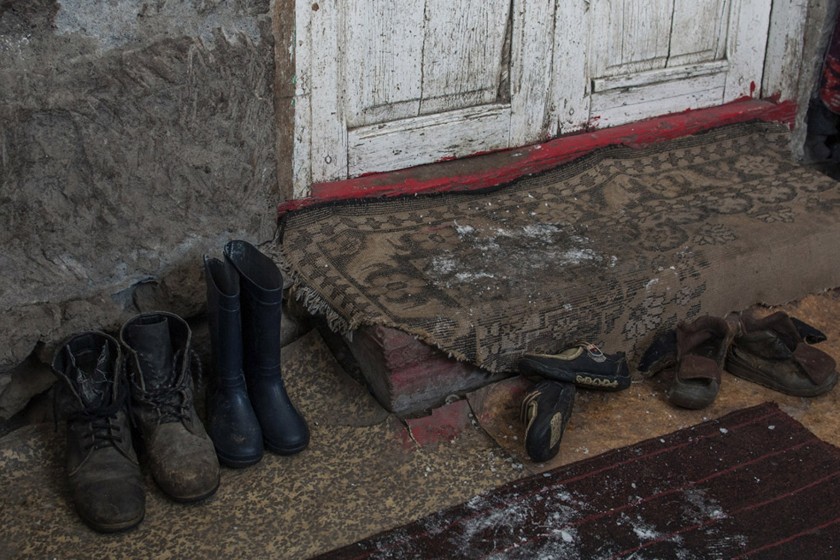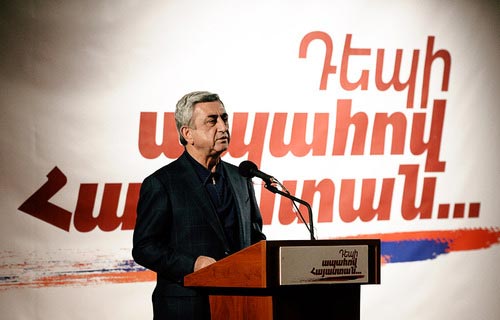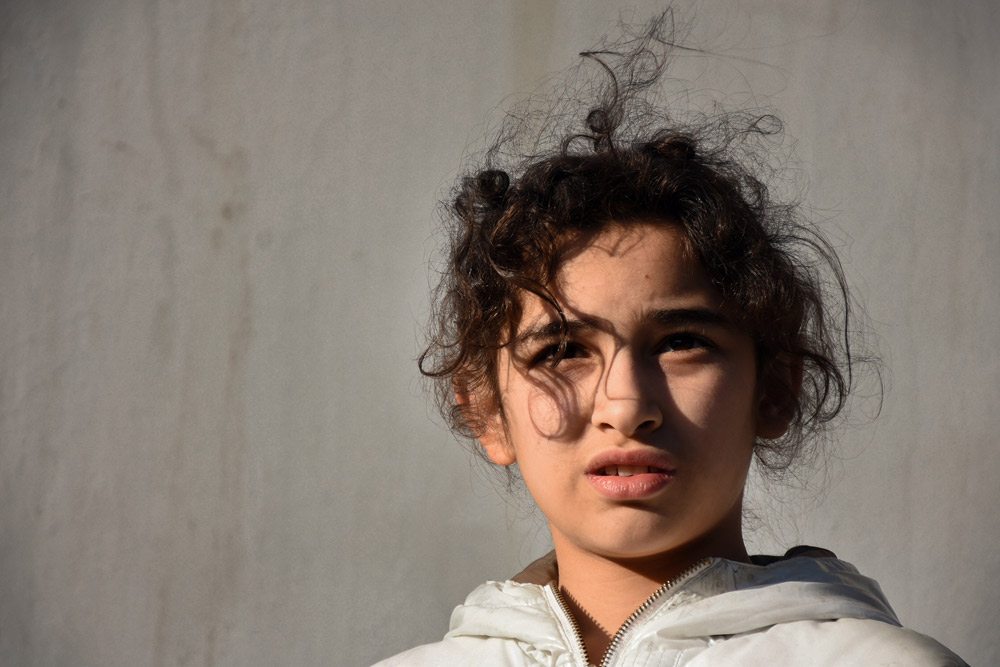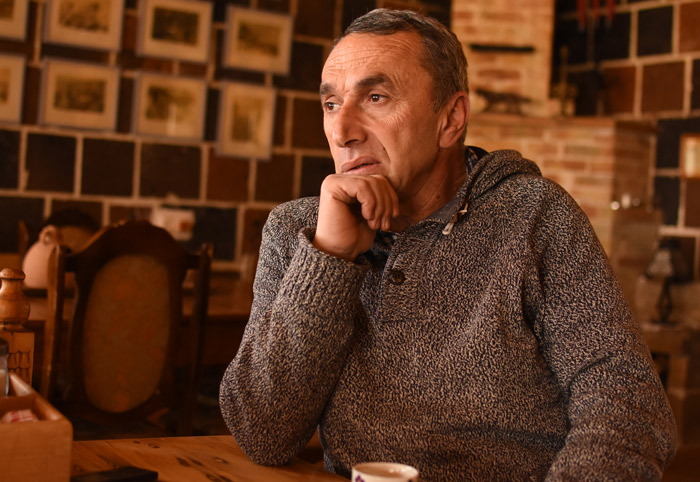
A Poorer Armenia Since 2008: President Sargsyan Falls Way Short on Campaign Promises
Marine Martirosyan
Vahe Sarukhanyan
When Serzh Sargsyan first ran to become the president of Armenia in 2008, with the campaign slogan of “Forward Armenia”, he declared the following in his stump speeches:
 “In the Armenia for which we strive, there will be no poor people, no privileged people…All must be safeguarded against the life-threatening events and the threat of poverty…We will do everything so that unemployment and poverty are finally overcome…”
“In the Armenia for which we strive, there will be no poor people, no privileged people…All must be safeguarded against the life-threatening events and the threat of poverty…We will do everything so that unemployment and poverty are finally overcome…”
Has Sargsyan lived up to his promises in the ten years he’s served as president of Armenia?
Data from the country’s National Statistical Service shows that 950,000 citizens of Armenia (26.4%), were living in poverty in 2008. (Armenia’s permanent population is officially given as 3.230 million)
By 2008, during Sargsyan’s first year in office, Armenia’s poverty rate rose to 27.6%. This number continued to increase, reaching 32.4% by the end of 2012.
 Sargsyan sought reelection in 2013 and ran with the campaign slogan – Toward a Secure Armenia. During the campaign, Sargsyan said: “We have reviewed our approach to overcoming poverty. This problem will not be solved merely with allowances and social payments. We must remove the causes of poverty. Each family must be able to maintain a decent way of life by working, and families facing difficulties must experience real help and support from the government.”
Sargsyan sought reelection in 2013 and ran with the campaign slogan – Toward a Secure Armenia. During the campaign, Sargsyan said: “We have reviewed our approach to overcoming poverty. This problem will not be solved merely with allowances and social payments. We must remove the causes of poverty. Each family must be able to maintain a decent way of life by working, and families facing difficulties must experience real help and support from the government.”
At a campaign stop in Vanadzor on January 31, 2013, Sargsyan said: “The rate of poverty will drastically fall due to economic development. We have already started down that path of economic development. Rich folk and a large middle class. This is the make-up of a secure Armenia that we can forge together.”
Officially, the level of poverty in Armenia was 32%; one out of every three citizens was living under the poverty line. There hasn’t been any significant improvement since.
The poverty rate dropped to 29.4% in 2016. This translates into 880,000 citizens out of a population of 2,998,600 living under the poverty line.
Since poverty figures have yet to be compiled for 2017, let’s focus on 2008-2016.
What is Poverty?
There is material and non-material poverty. Criteria for the latter include poor health, low education level or illiteracy, social neglect/unacceptance, being defenseless, non-application of rights and freedom of speech. In a word, on a practical level, the inability to talk about one’s own problems. For our purposes, we will be talking about material poverty.
 |
Single Mother of Three: Stella Vardevanyan says she’s unemployed |
The World Bank states that material poverty is when a person is unable to safeguard a certain minimally accepted standard of living.
These poverty lines/thresholds are estimated based on a minimum food basket and estimated share of non-food products.
According to the methodology used by the NSS:
Households whose consumption per adult equivalent was below the upper general poverty line were defined as poor; those whose consumption per adult equivalent was below the lower general poverty line were defined as very poor, whereas households whose consumption per adult equivalent was below food poverty line were defined as extremely poor.
These poverty lines/thresholds have differed over the years due to variations in product prices. For example, in 2008, individuals with a monthly consumption rate of 29,903 drams or less were considered poor. In 2016, that number rose to 40,867 drams.

Shirak: The Poorest Province in Armenia
Shirak had dubious distinction of being the poorest province in Armenia in 2008. It held that title in 2016.
Yerevan, the capital of Armenia, had the lowest rate of poverty in 2008. Aragatsotn Province held that distinction in 2016.
The poverty rate for rural residents is higher when compared to urban residents.
Poverty is a Sickness
Vahan Toumasyan, President of the Shirak Center NGO in Gyumri, describes poverty as a sickness. When people regard themselves as poor, Toumasyan says, they adapt to such a reality and view the world from that state of mind.
Founded in 2006, the Shirak Center has been running a program called Gyumri Without Huts. Toumasyan says that before the center was founded, he and his colleagues were engaged in social issues and defending voter rights. They realized that the issue, at its core, wasn’t the defense of rights but that people were hungry. Toumasyan recounts that the widespread poverty he saw in the late 1990s, while visiting people living in the huts, was unimaginable, even for someone like himself who lived in Gyumri.
 |
Gyumri Family of Eight: Hasmik doesn’t know what profession |
During the last twelve years, 100 families have received apartments through the Shirak Center. After the allocation, the center cuts its ties with the families. Toumasyan says he wants the families to feel a sense of ownership and forget that the apartments were donated.
“In Gyumri, as a rule, people haven’t chosen such a life. A disaster has forced them into such a state. People are diverse and live in different states. When you remove them from that state, they quickly change. Many of those 100 families are embarrassed to contact us. They want to forget all that,” Toumasyan says.
 Today, according to Toumasyan, there are 2,300 tnaks (container huts) in Gyumri. Some 500 are empty, but still standing, even after those living in them either moved or were allocated permanent housing. He says that those living in 450 in the remaining 1,800 wouldn’t move out even if offered other housing. They’ve turned the huts into homes, complete with small garden plots. This leaves 1,250 families who require permanent housing.
Today, according to Toumasyan, there are 2,300 tnaks (container huts) in Gyumri. Some 500 are empty, but still standing, even after those living in them either moved or were allocated permanent housing. He says that those living in 450 in the remaining 1,800 wouldn’t move out even if offered other housing. They’ve turned the huts into homes, complete with small garden plots. This leaves 1,250 families who require permanent housing.
Toumasyan says thirty years is time enough for such issues to be resolved and the town rehabilitated. He points to Europe after WWII and how quickly life returned to normal. In Gyumri’s tnakneighborhoods, it’s as if the 1988 Spitak Earthquake happened yesterday.
Toumasyan recounts a few instances when well-off oligarch MPs requested that he give them a tour of the tnaks. After entering one or two, the MPs called off the tour, saying their weak constitutions couldn’t take much more. The MPs were getting irritated.
Read Hetq’s coverage on poor families in Armenia HERE

Since 2008, 1 in 3 Children in Armenia are Poor
According to 2016 official statistics, one in three children aged 0-18 in Armenia lives under the poverty line.
The below graph shows that the lowest poverty rate for children in Armenia during the period 2008-2016 was in 2008, when Sargsyan started his first term as president. Since then, it’s never been below 33%.
The rates of child poverty in Yerevan and the country’s provinces are drastically different. The lowest rate for 2016 was in Aragatsotn, the highest in Shirak.
The NSS estimates that it would have cost AMD 71.4 billion (1.4% of GDP) to do away with poverty in 2015, and AMD 1.8 billion (0.04% of GDP) to remove extreme poverty.
These amounts are in addition to the AMD 63.2 billion the government already spends on social assistance to the poor and the AMD 1.4 billion it allocated in assistance to the extremely poor.
The NSS confesses that international practice proves that due to the unlikeliness that all such funds are reaching those in need, the amounts needed to “wipe out” poverty in Armenia are much higher.
 Videos
Videos Photos
Photos




Comments (2)
Write a comment